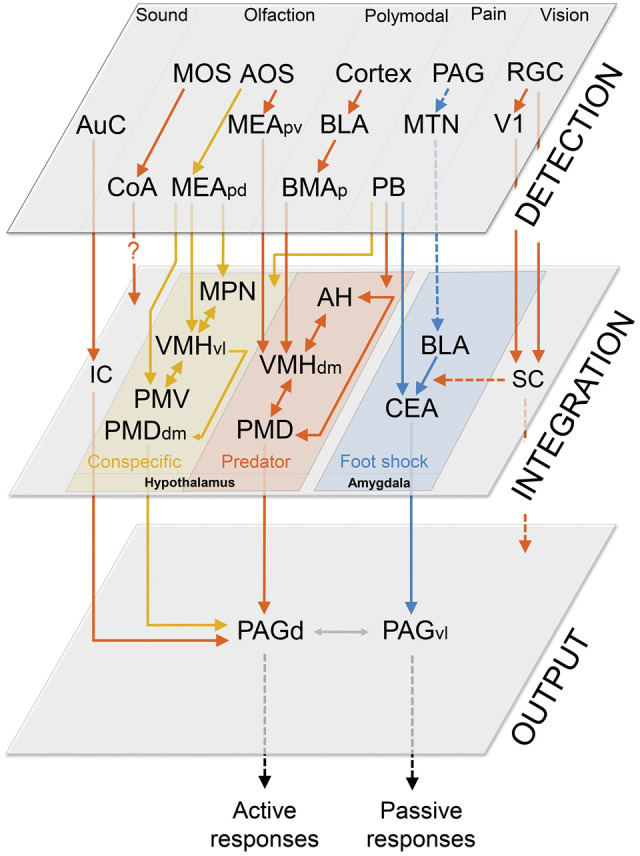Figure 1.

Schematic representation of the neural circuits mediating innate fear to different threats. Three main functional units process innate fear, a detection unit (upper plane), an integration unit (middle plane), and an output unit (lower plane). Information about the threat is collected through different sensory modalities. Acoustic inputs (such as ultrasounds) are processed by the auditory cortex (AuC), which in turn projects to the inferior colliculus (IC) that sends afferents to the dorsal periaqueductal gray (PAGd). Moving visual stimuli in the upper visual field are processed by the superior colliculus (SC), which receives inputs from the retinal ganglion cells (RGN) and primary visual cortex (V1) and mediates fear responses through targeting the amygdala and brainstem. Olfaction plays a crucial role in the detection of both predator (orange) and conspecific (yellow) signals. The main olfactory system (MOS) mediates defensive responses to the predator odor via projections to the cortical amygdala (CoA), but the outputs of this structure mediating behavioral responses remain unclear. The accessory olfactory system (AOS) signals conspecific cues to the posterior dorsal portion of the medial amygdala (MEAdd) and predator cues to its posterior ventral portion (MEApv). These two medial amygdalar nuclei project to the conspecific and predator integration circuits in the hypothalamus. The predator fear circuit also receives polymodal sensory information about the threat via a basolateral amygdala (BLA)-basomedial amygdala (BMA) circuit. The hypothalamic integration unit processing conspecific fear includes four highly interconnected nuclei: the medial preoptic nucleus (MPN), the ventrolateral portion of the ventromedial hypothalamic nucleus (VMHvl), ventral premammillary nucleus (PMV), and dorsomedial portion of the dorsal premammillary nucleus (PMDdm). The conspecific fear circuit mediates defensive responses through its projections to the PAGd. The predator fear circuit consists of the anterior hypothalamic nucleus (AH), the VMHdm, and the PMD and mediates defensive responses through projections to the PAGd. Importantly, both the conspecific and predator hypothalamic circuits receive nociceptive information from the parabrachial nucleus (PB). Defense to painful stimuli (blue lines) such as an electrical footshock is mediated by activation of the ventrolateral periaqueductal gray (vlPAG) via the central nucleus of the amygdala (CEA). The CEA receives noxious information from the parabrachial nucleus (PB). The basolateral amygdala complex (BLA) plays a major role in footshock-induced fear through its projections to the CEA. The BLA integrates nociceptive information from the PAG via midline thalamic nuclei (MTN).
